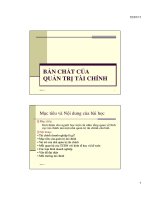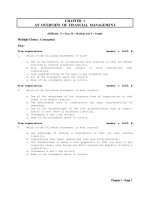Overview of financial management
Bạn đang xem bản rút gọn của tài liệu. Xem và tải ngay bản đầy đủ của tài liệu tại đây (103.59 KB, 2 trang )
Topic: Financial Management
Overview of Financial Management
Q. What does good financial management involve?
A. Good financial management involves planning, organizing, controlling
and monitoring resources so that your organization can achieve its objectives
and fulfill its commitments to beneficiaries, donors and other stakeholders.
Good financial management requires more than simply keeping accurate
accounting records. Many NGOs may have only an accounting or bookkeeping
system rather than a financial management system. Accounting is a subset of
financial management. A financial management system encompasses both
administrative systems and accounting systems.
Administrative systems provide the framework for handling procurement, travel,
inventory, facilities and personnel matters such as payroll and benefits.
Accounting systems encompass the methods, procedures and controls
established to gather, record, classify, analyze, summarize, interpret and
present accurate and timely financial data.
Key Pillars of Financial Management
Although one model of financial management does not fit every organization,
the following components are essential to good financial management:
• Planning. Looking ahead to prepare for the future, such as developing
budgets to cover activities of a program or the entire organization for
one year or a longer period of time.
• Organizing. Clarifying who does what, why, when and how.
• Controlling. Establishing systems and procedures, checks and
balances, to make sure that the financial resources of the organization
are properly handled and that risks are managed.
• Monitoring.
Comparing objectives with actual performance to identify
strengths and weaknesses in planning and implementation and
adjusting as necessary.
-more-
Accounting
Systems
+
Administration
Systems
=
Financial
Management
Definitions
Financial management—Planning,
organizing, controlling and monitoring
financial resources to support the
objectives and functioning of an
organization.
Financial management manual—
A collection of the policies and practices
that describes how an organization
conducts its day-to-day fiscal affairs.
Issue 43/May 2012
References
U.S. Government Standards for
Financial Management Systems
U.S. Code of Federal Regulations
22 CFR 226.21
/>/waisidx_10/22cfr226_10.html
Practical Financial Management
for NGOs—Getting the Basics
Right. Mango (Management
Accounting for Non-governmental
Organisations)
A Practical Guide to the Financial
Management of
NGOs. Namibia
Institute for Democracy
/>Financial%20training%20manual.pdf
/>Financial%20training%20manual.pdf
2
Issue No. 43 /May 2012
Who is responsible for financial management?
Staff members at every level have a role to play in helping manage risks,
answer to donors and beneficiaries and deliver results for the organization. The
Board is responsible for the financial oversight of your organization and is
ultimately accountable by law. However, the Board typically delegates the day-
to-day responsibilities to the executive director or top management who
delegate some functions to senior managers. The senior managers, in turn,
delegate some functions downward, and so on, as illustrated in the table that
follows.
Players in
Financial
Management
Sample responsibilities
Board of Directors
(Trustees)
• Oversee financial controls and ensure accountability
• Review and approve annual budget
• Approve financial policies, including delegating authority
• Review and approve financial reports and audited financial
statements
• Monitor and support resource mobilization
• Assess financial risks facing the NGO
Chief Executive
Officer- CEO
(Executive
Director)
• Report to the Board and manage budgeting process
• Appoint/hire financial staff and delegates tasks
• Review donor and other agreements/contracts
• Ensure financial records are accurate and up to date
• Ensure correct, timely preparation and submission of financial
reports
• Ensure that program activities are in line with budget and
deliverables
• Monitors resource use and manages income generation
• Monitors financial needs of the organization and business
planning
Senior Managers
• Manage and monitor the budgets for their departments or
projects
• Review organization financial reports and give input to CEO
• Further delegate some financial responsibilities to their team
• Projects future financial needs
Program Staff
• Set project budgets to ensure that all costs are included (such as
deliverables, M&E implementation)
• Control budgets to ensure money is spent as agreed and work
with finance staff to ensure policies and procedures are followed,
expenditures are coded and reported accurately,
• Work with appropriate staff to ensure that procurements are
best value for money
Finance Staff
• Handle the NGO’s cash, including banking and issuing receipts
• Administer the payment process to ensure bills are paid on time
• Complete the books of accounts and reconcile them every month
• Prepare internal and external financial reports.
Review USG Financial System Minimum Requirements
The U.S. Code of Federal Regulations (CFR) provides a set of minimum
requirements that an NGO’s financial management system must meet before it
can receive a USG award and must maintain throughout the period of
performance. Detailed information is available online at
Create a Financial Management Manual
Document how your administrative and accounting systems work. There is no
single model financial management manual, and yours will depend on the
needs and structure of your organization. However, the sample table of
contents in the left column is a good starting point. Print and assemble the
policies and procedures in a manual that is shared with staff and readily
accessible to everyone.
NGO Financial
Management Manual
Sample Table of Contents
• Financial accounting routines
• The Chart of Accounts and cost
center codes
• Delegated authority rules (i.e.
who can do what)
• The budget planning and
management process
• Ordering and purchasing
procedures
• Bank and cash handling
procedures
• Management accounting routines
and deadlines
• Management and control of fixed
assets
• Staff benefits and allowances
• Annual audit arrangements
• How to deal with fraud and other
irregularities
• Code of Conduct for staff and
board members
The manual may also include
reference materials such as:
• Organization Chart
• Job descriptions
• Standard forms
• Glossary and/or list of acronyms
and abbreviations
Source: Practical Financial Management for
NGOs—Getting the Basics Right. Terry Lewis.
Mango (Management Accounting for Non-
governmental Organisations) 2009.
G
ood financial management
enhances your accountability to
your donors and beneficiaries.
It also builds respect for and
confidence in your organization,
improving your chances for
long term financial health.









